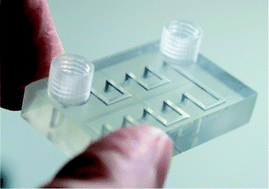Customisable 3D printed microfluidics for integrated analysis and optimisation†
Abstract
The formation of smart Lab-on-a-Chip (LOC) devices featuring integrated sensing optics is currently hindered by convoluted and expensive manufacturing procedures. In this work, a series of 3D-printed LOC devices were designed and manufactured via stereolithography (SL) in a matter of hours. The spectroscopic performance of a variety of optical fibre combinations were tested, and the optimum path length for performing Ultraviolet-visible (UV-vis) spectroscopy determined. The information gained in these trials was then used in a reaction optimisation for the formation of carvone semicarbazone. The production of high resolution surface channels (100–500 μm) means that these devices were capable of handling a wide range of concentrations (9 μM–38 mM), and are ideally suited to both analyte detection and process optimisation. This ability to tailor the chip design and its integrated features as a direct result of the reaction being assessed, at such a low time and cost penalty greatly increases the user's ability to optimise both their device and reaction. As a result of the information gained in this investigation, we are able to report the first instance of a 3D-printed LOC device with fully integrated, in-line monitoring capabilities via the use of embedded optical fibres capable of performing UV-vis spectroscopy directly inside micro channels.


 Please wait while we load your content...
Please wait while we load your content...